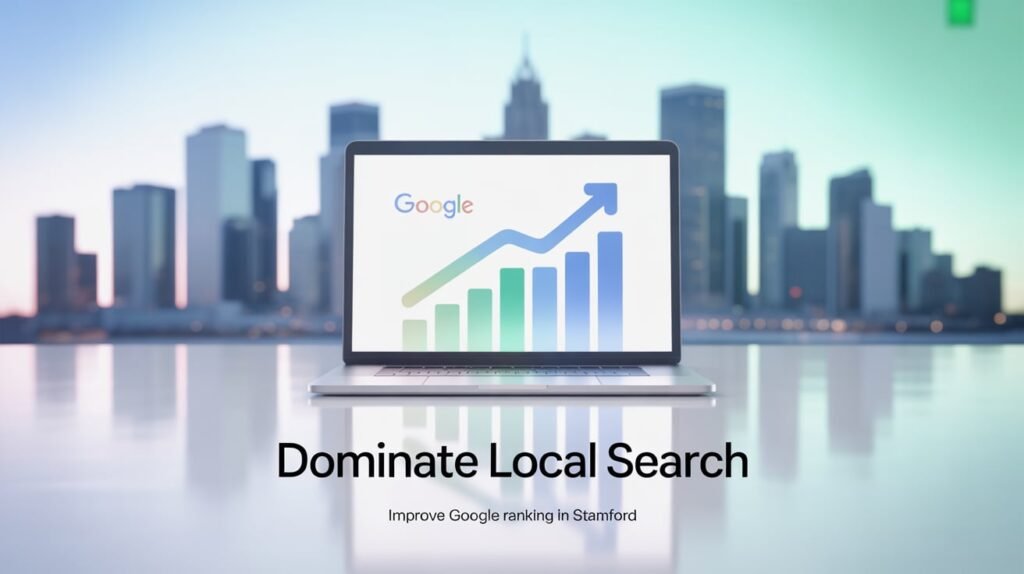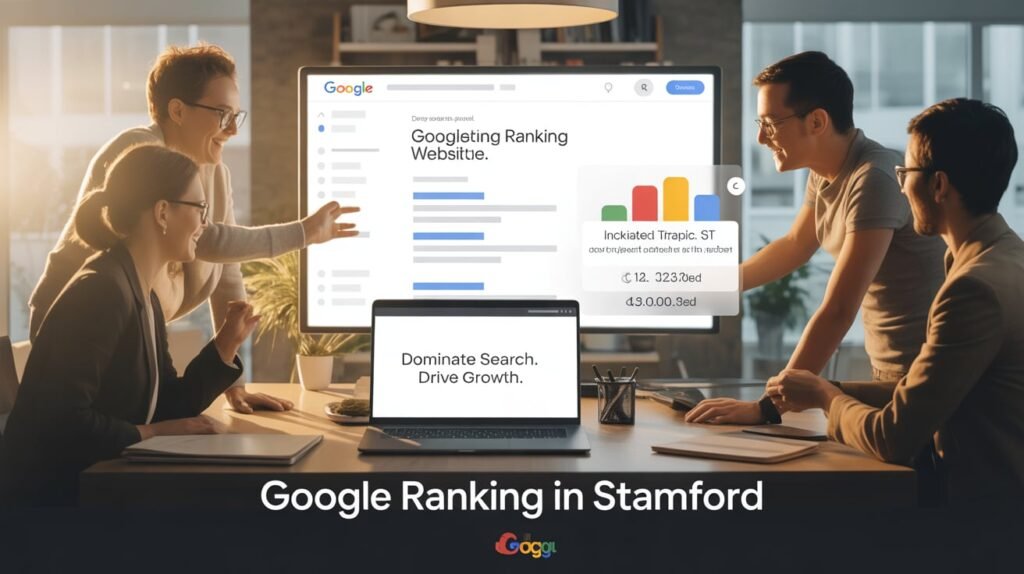If you run a business in Stamford, UK, getting your website to rank higher on Google is critical for attracting local customers and boosting your online presence. Improve Google ranking in Stamford involves a mix of on-page SEO, technical optimization, local search strategies, and high-quality content creation. This guide shares actionable, proven methods to enhance your website’s visibility, tailored specifically for businesses in Stamford. Whether you are a small shop in the historic town center or an e-commerce site serving the region, these strategies will help you stand out in search engine results pages (SERPs).
Why Google Rankings Matter for Stamford Businesses
Stamford, with its vibrant local economy and growing digital landscape, is a competitive market for businesses aiming to capture local search traffic. Ranking high on Google means more visibility, clicks, and ultimately, customers walking through your door or visiting your website. Google’s algorithms prioritize websites that deliver value, relevance, and a great user experience. By focusing on local SEO, content optimization, and technical best practices, you can improve your ranking for search terms like “best coffee shop in Stamford” or “Stamford plumber near me.”
In this guide, we will cover key strategies, including keyword research, on-page and off-page SEO, technical enhancements, and local optimization techniques. We will also explore how to create engaging, people-first content that aligns with Google’s E-E-A-T (Experience, Expertise, Authoritativeness, Trustworthiness) guidelines and resonates with both users and search engines.

Step 1: Conduct Targeted Keyword Research for Stamford
Keyword research is the foundation of any successful SEO strategy. For Stamford businesses, this means identifying terms your local audience uses when searching for your products or services. Focus on long-tail keywords and location-specific phrases to capture high-intent searchers.
How to Find the Right Keywords
- Use Keyword Tools: Tools like Google Keyword Planner, Semrush, or Ahrefs can help identify high-traffic, low-competition keywords relevant to Stamford. For example, instead of targeting broad terms like “SEO services,” aim for “SEO services in Stamford, UK” or “best web design Stamford.”
- Analyze Competitor Keywords: Look at competitors ranking well in Stamford. Tools like Semrush allow you to see which keywords drive traffic to their sites, helping you uncover gaps in your strategy.
- Incorporate LSI Keywords: Latent Semantic Indexing (LSI) keywords are related terms that add context. For example, alongside “improve Google ranking in Stamford,” include phrases like “local SEO Stamford,” “website optimization,” or “search engine visibility.”
- Focus on Search Intent: Google prioritizes content that matches user intent (informational, navigational, commercial, or transactional). For instance, a blog post titled “How to Choose a Plumber in Stamford” addresses informational intent, while “Book a Plumber in Stamford Today” targets transactional intent.
Pro Tip: Use Google’s “People Also Ask” and “Related Searches” sections to find questions your audience is asking, such as “How can I improve my website ranking in Stamford?” Incorporate these into your content to boost relevance.
Step 2: Optimize On-Page SEO Elements
On-page SEO involves optimizing elements on your website to make it more search-engine-friendly. For Stamford businesses, this means ensuring every page is tailored to local search terms and user needs.
Key On-Page SEO Tactics
- Title Tags: Include your primary keyword, such as “Improve Google Ranking in Stamford, UK,” in the title tag. Keep it under 60 characters to avoid truncation. For example: “Top Tips to Improve Google Ranking in Stamford, UK.”
- Meta Descriptions: Write compelling meta descriptions (under 160 characters) that include your keyword and a call-to-action. Example: “Boost your website’s ranking in Stamford, UK with expert SEO tips and local strategies.”
- Headings (H1, H2, H3): Use a clear hierarchy with your primary keyword in the H1 tag and LSI keywords in subheadings. For example, H2s like “Local SEO for Stamford Businesses” or “Content Strategies for Better Rankings.”
- Content Optimization: Sprinkle your primary and secondary keywords naturally throughout the content. Aim for a keyword density of 1-2% to avoid stuffing. For instance, use phrases like “Stamford SEO services” or “website ranking tips” contextually.
- Internal Linking: Link to relevant pages on your site, such as service pages or other blog posts, to improve navigation and distribute page authority. For example, link to a page about “Stamford web design services” from a blog post about SEO.
- Image Optimization: Use descriptive file names (e.g., stamford-seo-services.jpg) and alt text with keywords to improve image search rankings. Compress images to enhance page speed.
Pro Tip: Ensure your content is scannable with short paragraphs, bullet points, and subheaders to improve readability and user engagement.
Step 3: Leverage Local SEO for Stamford
Local SEO is crucial for businesses targeting customers in Stamford. Google prioritizes local results for queries like “restaurants near me” or “Stamford hair salon,” making it essential to optimize for location-based searches.
Local SEO Strategies
- Optimize Your Google Business Profile: Create or update your Google Business Profile with accurate details, including your Stamford address, phone number, hours, and high-quality images. Encourage customers to leave positive reviews to boost credibility.
- Local Citations: Submit your business to local directories like Yell, Yelp, and Stamford-specific listings. Ensure your Name, Address, and Phone Number (NAP) are consistent across all platforms.
- Location-Specific Content: Create blog posts or landing pages targeting Stamford-related keywords, such as “Best Cafes in Stamford, UK” or “Why Choose a Stamford SEO Agency.”
- Schema Markup: Add local business schema markup to your website to help Google understand your location and services. This can enhance your chances of appearing in rich snippets or map results.
Case Study Example: A Stamford eco-friendly retailer used local SEO to boost organic traffic by 45% in six months. By optimizing their Google Business Profile, targeting long-tail keywords like “sustainable home goods Stamford,” and creating locally relevant blog content, they appeared in 70% of local searches for eco-friendly products.
Step 4: Focus on Technical SEO
Technical SEO ensures your website is crawlable, fast, and user-friendly, all of which are critical for ranking well in Google’s algorithm.
Technical SEO Best Practices
- Site Speed: Use tools like Google PageSpeed Insights to identify and fix issues slowing your site. Compress images, minify CSS/JavaScript, and enable browser caching.
- Mobile-Friendliness: Ensure your website is responsive across devices, as Google prioritizes mobile-first indexing. Test with Google’s Mobile-Friendly Test tool.
- Secure HTTPS: Use an SSL certificate to secure your site, as Google favors HTTPS websites.
- Fix Crawl Errors: Use Google Search Console to identify and resolve broken links, redirect errors, or indexing issues.
- XML Sitemap: Submit an XML sitemap to Google Search Console to help crawlers index your pages efficiently.
Pro Tip: Regularly audit your site using tools like Semrush or Ahrefs to identify technical issues and track improvements.
Step 5: Create High-Quality, People-First Content
Google’s algorithms, including its AI Overview, prioritize content that demonstrates expertise, authority, and trustworthiness. For Stamford businesses, this means creating content that resonates with your local audience while addressing their needs.
Tips for Creating SEO-Friendly Content
- Answer User Questions: Write blog posts that address common queries, such as “How to improve Google ranking for small businesses in Stamford” or “What is local SEO for Stamford shops?”
- Use Engaging Formats: Incorporate lists, how-to guides, and case studies to make content scannable and valuable. For example, a listicle titled “10 Ways to Boost Your Stamford Business’s Google Ranking” is both engaging and SEO-friendly.
- Include Multimedia: Add images, infographics, or videos to enhance engagement. For example, a video showing “How a Stamford Bakery Improved Its Google Ranking” can attract both users and search engines.
- Update Content Regularly: Refresh old blog posts with new data, statistics, or keywords to maintain relevance. For instance, update a 2023 post about Stamford SEO trends with 2025 insights.
- Showcase Expertise: Include author bios with credentials to boost E-E-A-T. For example, “Written by Jane Doe, a Stamford-based SEO expert with 10 years of experience.”
Pro Tip: Use tools like Semrush’s SEO Writing Assistant to check readability and optimize content for both users and search engines.
Step 6: Build Quality Backlinks
Off-page SEO, particularly backlink building, signals to Google that your website is authoritative and trustworthy. For Stamford businesses, focus on earning backlinks from local and industry-relevant sites.
Backlink Strategies
- Guest Posting: Write guest posts for local blogs or industry websites, such as Stamford Living or UK business directories, linking back to your site.
- Local Partnerships: Collaborate with Stamford charities, events, or businesses to earn mentions and links.
- Content Promotion: Share your blog posts on social media platforms like Instagram and Facebook to encourage shares and links from local audiences.
- Avoid Low-Quality Links: Focus on high-authority sites to avoid penalties from Google’s algorithms.
Pro Tip: Use tools like Ahrefs to monitor your backlink profile and disavow toxic links that could harm your rankings.
Step 7: Monitor and Adjust Your SEO Strategy
SEO is an ongoing process, not a one-time task. Regularly track your performance and adjust your strategy based on data.
How to Monitor SEO Performance
- Google Analytics: Track organic traffic, bounce rates, and user behavior to measure success.
- Google Search Console: Monitor keyword rankings, click-through rates, and indexing status.
- Monthly Audits: Conduct SEO audits to identify new opportunities or issues, such as outdated content or technical errors.
- Competitor Analysis: Keep an eye on competitors’ rankings and strategies to stay ahead in the Stamford market.
Pro Tip: Set realistic timelines for results. Expect initial improvements in 3-6 months, with significant ranking gains after 12 months of consistent effort.
Step 8: Leverage AI Tools for SEO Efficiency
AI-powered tools can streamline your SEO efforts, especially for content creation and optimization. Tools like Junia AI or Semrush’s SEO Writing Assistant can analyze top-ranking pages, suggest keywords, and ensure your content aligns with search intent. However, always review AI-generated content to ensure it reflects your brand voice and expertise.
Pro Tip: Use AI to draft outlines or optimize product descriptions, but add human insights to maintain authenticity and avoid penalties for over-optimized content.
Common Mistakes to Avoid
- Keyword Stuffing: Overusing keywords like “improve Google ranking in Stamford” can harm readability and rankings.
- Ignoring User Experience: Prioritize fast load times, easy navigation, and mobile-friendliness to keep visitors engaged.
- Neglecting Local SEO: Failing to optimize for Stamford-specific searches limits your visibility to local customers.
- Not Updating Content: Outdated content loses relevance, so refresh blogs and pages regularly.

FAQs
How long does it take to improve Google ranking in Stamford?
SEO results typically take 3-6 months for initial improvements and 6-12 months for significant ranking gains, depending on competition and consistency.
Why is local SEO important for Stamford businesses?
Local SEO helps your business appear in location-based searches, driving foot traffic and inquiries from Stamford residents.
What are the best tools for SEO in Stamford?
Tools like Google Keyword Planner, Semrush, Ahrefs, and Google Search Console are excellent for keyword research, competitor analysis, and performance tracking.
How can I optimize my Google Business Profile for Stamford?
Ensure accurate details, add high-quality images, encourage reviews, and post regular updates to boost local visibility.
Is AI content safe for SEO?
AI-generated content can be effective if edited for authenticity and aligned with E-E-A-T principles. Avoid publishing unedited AI content to prevent penalties.
Conclusion
Improving your Google ranking in Stamford, UK, requires a strategic blend of keyword research, on-page and technical SEO, local optimization, and high-quality content. By focusing on user intent, leveraging local opportunities, and maintaining a consistent SEO strategy, your business can climb the SERPs and attract more customers. Start with a site audit, optimize your Google Business Profile, and create engaging, Stamford-focused content to see measurable results. Stay patient, track your progress, and refine your approach to stay ahead in this competitive market.


